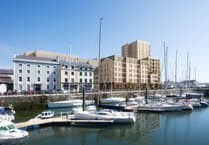A small museum on the island has big plans to expand with a new exhibit and a sculpture.
The Manx Aviation and Military Museum, located next to the Isle of Man Airport, recently announced its best ever year for visitor numbers with more than 8,000 visitors coming through its doors in 2024–25.
Since opening in 2000, the museum’s attendance has grown steadily, with a marked increase in the post-Covid years.
Now, the museum owners have submitted plans to install the fuselage of an aircraft and also place a bronze sculpture as a memorial to lost aviators.
In the planning statement, the applicant says: ‘Part one of this proposal is to install the forward fuselage section of a retired passenger aircraft (a British Aerospace ATP) as a permanent addition to the museum and form additional display space. The nose section will also form an exhibit in its own right.
‘As part of the installation, it is proposed to replace deteriorated timber cladding to the covered walkway between buildings.
‘Part two is the installation of a bronze sculpture with the working title ‘The Angel of Ronaldsway’ to be a memorial to the aviators who have left the airfields of the Isle of Man, never to be seen again.’
Earlier this week, museum director Ivor Ramsden expressed delight at the growth in both visitors and positive feedback.

He said: ‘We’re not only seeing more people but we’re also receiving more appreciative comments and top online reviews.
‘It’s a testament to the quality of our exhibits and the warm welcome from our volunteers, whose enthusiasm I truly value.’
Among the displays at the museum is the First World War exhibition.
Mr Ramsden explained: ‘History books don’t show the real lives of those involved.
‘We tell the stories of ordinary Manx people - fishermen, farm workers, horse tram conductors- many of whom never came home. Their medals, belongings, and photos bring their stories to life.’
He also noted the often-overlooked role of animals: ‘Hundreds of horses were taken from farms and trams to the front lines. We only know of one that returned, and her story is included.’
The museum also features exhibitions on Manx involvement in the Royal Navy, the Isle of Man’s connections with the Royal Air Force, the history of Ronaldsway airfield, and the many civil airlines that have operated in the island.
A major section is dedicated to the Manx Regiment, which fought in Southern England, North Africa, Italy, and North-West Europe. It was the first British unit to fire its guns in WWII and ended the war as the top-scoring anti-aircraft unit among the Allies.
The planning application will be considered by the planning committee in due course.
Admission to the museum is free, with donations and gift shop sales helping fund the attraction.
Open daily during the Easter school holidays and weekends thereafter, the museum resumes daily hours in TT practice week. It operates as a registered charity.
-(1).jpeg?width=752&height=500&crop=752:500)



